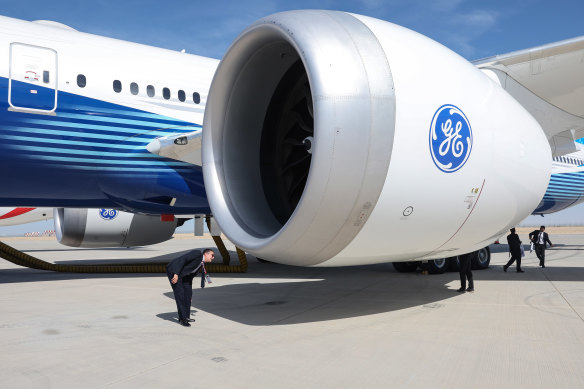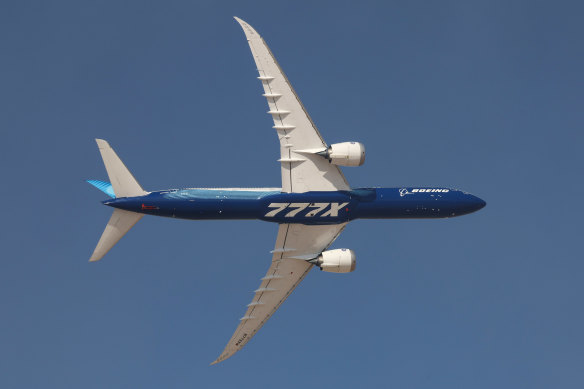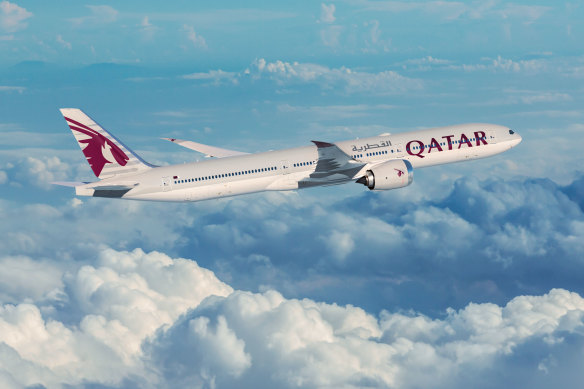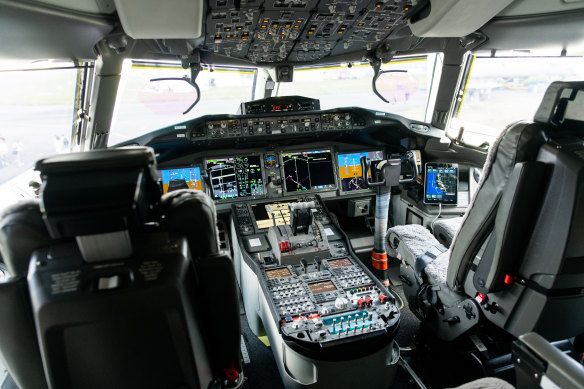New Boeing will be the world’s longest, widest passenger plane
By John Arlidge
Last month Jack Hayward, senior first officer at British Airways, tweeted: “Exciting times as BA announces the intention to operate Boeing 777-9 aircraft as part of our fleet.
“There has never been a better time to join us – flying the biggest and best jets to all four corners of the globe.”

The Boeing 777-9 on display at the Dubai Air Show last year. Credit: Getty Images
He was writing shortly after America’s Federal Aviation Administration (FAA) granted permission for Boeing to conduct the first certification flights of its new jet.
It’s not hard to see why a pilot might be excited at the prospect of the 777-9. After the four-engine Boeing 747 flew into the history books of most airlines during the pandemic and Airbus scrapped the production of its double-decker successor, the A380 superjumbo, the world has needed a new giant of the skies.
Boeing – and Hayward – are convinced that the 777-9 is it.
So what is special about the 777-9 and what do passengers – and pilots – have to look forward to?
The largest new commercial jet soon to be available to airlines may be a successor to the jumbo and the A380 but it is, alas, a single-decker plane.
There are no stairs that fancy fliers can ascend to the bubble on the top deck. Double-deckers require four engines and none but a handful of carriers want to operate four-engine jets any more because they consume too much fuel per passenger.
The 777-9 does, however, have some snazzy design features.
To improve fuel efficiency and help to combat turbulence, which many analysts say is getting more frequent and more severe, the wings are the longest on any commercial jet, with a span of 235 feet (72 metres).

The 777-9 has the widest wingspan of any commercial airliner.Credit: Getty Images
They are so long that in order to park at the gates in most airports, the tips will fold up after the plane has landed, like on a fighter jet, which will allow First Officer Hayward to indulge his Top Gun fantasies.
The fuselage is the longest of any commercial jet, more than 250 feet (76 metres), allowing airlines to carry up to 426 passengers, depending on how many classes they offer. New lean-burn engines mean it can fly for more than 13,500 kilometres in one hop, making non-stop flights from London to Hawaii possible.
This is a shorter range than the 777-8 variant, with capacity for 395 passengers, which was considered by Qantas for its long-awaited Project Sunrise, aimed at launching non-stop from Australia’s east coast to destinations such as New York and London. The airline opted to go with Airbus’ A350-1000 instead.
Boeing already has 481 orders for the new jet, which has a list price of $651 million. Qatar Airways and Emirates, which will be among the first carriers to fly it, will use the 777-9 to install brand new first-class cabins, just as they used the A380 to introduce halo products, such as suites, bars and showers. British Airways and Singapore Airlines will follow suit.
The jet is so large that most airlines will go for a four-class configuration: economy, premium economy, business and first. The width of the fuselage means that there will be 10 seats across in economy, arranged three-four-three across the cabin.

Boeing already has 481 orders for the new 777-9 jet, including from BA, Qatar Airways and Emirates. Credit: Boeing
Most passengers would prefer nine but Boeing insists the seats will still be roomier than most economy seats. Passengers in every cabin will have something of a view because the windows will be the largest on a jet of this size.
Boeing says the 777-9 will boast the most advanced air filtration systems to keep the air cleaner and less dry than on rival jets.
The cabin will be pressurised at an altitude of 6000 feet (1800 metres), the lowest pressure possible, which will prevent passengers’ legs and ankles swelling. LED lighting systems will enable airlines to change the brightness and tone from “sunrise” to “sunset”, and even show a “starry night sky”, to try to nudge travellers on to the time zone of their destination and reduce jet lag.
The 777-9’s long wing span and GE9X engines mean it will be more efficient than competing aircraft, such as the Airbus A350-1000, and will have 10 per cent lower operating costs, Boeing claims.

Boeing hopes its 777-9s will be approved to go into service next year.Credit: Getty Images
Brad Till, the firm’s managing director of commercial aeroplanes product marketing and analysis, says: “This aircraft will have the lowest CO2 emissions per seat of any wide-body flying.
The new engine technology also delivers lower NOx [nitrogen oxides] emissions and less noise, both in the cabin for the passengers and for our airport communities, compared to the aeroplanes that this will replace.”
It’s not only the width and efficiency of the 777-9 that surpass its competitors: it has been more delayed than any new aircraft.
It was announced in 2014 but its development has been set back by the pandemic, supply chain snarl-ups, troublesome testing programmes and the distraction posed by the FAA’s investigation into the corner-cutting which was responsible for the botched development of the short-haul 737 Max 8 model.
Some 346 people died in two separate crashes in 2018 and 2019 when first an Indonesian Lion Air Boeing 737 Max 8 short-haul jet and then an Ethiopian Airlines Max 8 plummeted to the ground shortly after take-off.
Boeing ended production of its 747 jumbo jet in 2023, more than half a century after its first flight in 1969.
Boeing’s woes deepened earlier this year when a door panel on a 737 Max blew out at 16,000 feet (4800 metres) and reports emerged that some of the company’s long-haul 787 “Dreamliner” jets had not been assembled and maintained correctly.
Boeing has agreed to plead guilty to criminal fraud in the development of the Max and to pay hundreds of millions of dollars in fines in a proposed settlement with the FAA.
Boeing built a handful of 777-9s for Emirates but they were never delivered because the aircraft had not been certified as safe to fly in time. The interiors had to be scrapped since they would have been out of date by the time the jets finally came into service. Now that the 777-9 is undergoing certification flights, Boeing hopes it will be approved to go into service next year. But in yet another setback, last month the company was forced to ground its test fleet temporarily due to the discovery of cracks in an engine component.
The Telegraph, London
Sign up for the Traveller newsletter
The latest travel news, tips and inspiration delivered to your inbox. Sign up now.